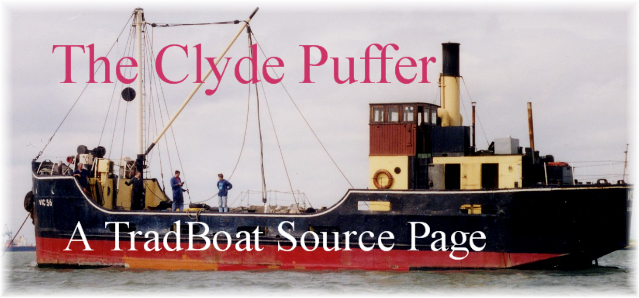

This page
normally has an index to the left. If you see it without, please click here
A
short history of the "puffer".
The earliest “puffers” date from the mid to late 1800s. At
first they were essentially canal vessels and the dimensions
of the early Clyde puffers were governed
by the size of the locks on 39 miles of the Forth & Clyde Canal through which they
worked. A
length of around 66 feet (20.30m) and a beam of 16 to 18 feet (5.54m) seems to
have been the norm.
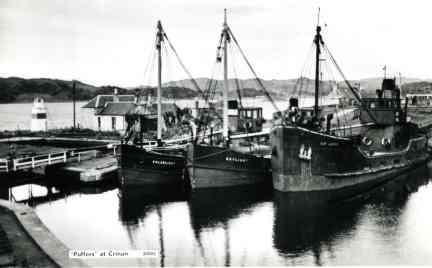
Puffers Portlight, Raylight and Sir James at Crinan. Courtesy the Crawford Alexander Collection
The outside boats develop
Design of these canal vessels changed as they began to work out into estuarial waters
producing “shorehead” types. By the late 1800s more robust seagoing “outside” boats were
being developed. They had greater freeboard, but were built to the familiar 66 foot length so
that the Forth & Clyde continued to be open to them. A number of “outside”
boats were were also built to around 80 feet
overall (26.60m).
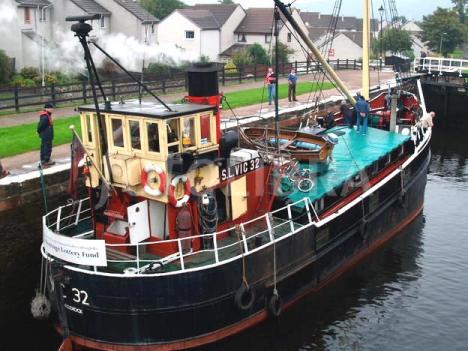
VIC 32 Photo: Peter Wilberforce (See below for details of this Puffer)
The
coming of the VIC
The puffer continued in use until the first World War but numbers gave way to
road transport and to the increasing cost of coal and maintenance; the last of
the “true” puffers were built in 1930 - 39.
However, with the advent of World War II vessels of this
type were again needed, this time for fleet work, and the Ministry ordered the
construction of Victualling Inshore Craft (VICs), to be built on the lines of Anxac
and Lascar (1939 boats). In
all over 100 VICs were built between 1941 and 1946, the great majority to be in
steam and a few only with diesel propulsion.
VICs built between 1941 and 1944 were, in the main 66.8 feet overall
(20.50m approx). With VIC 49, boats at 80.5 overall (29.6m approx) were
introduced and many were built at this length by the end of the war.
P
The
Puffer today
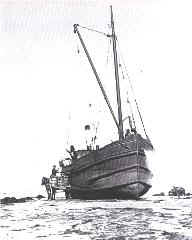 A
few Puffers remain as you will see from the list below.
In the main they are the later VICs but the early 1902 boat Basuto
is still afloat at the National Waterways Museum in Ellesmere Port. Why
the curious name ? That name came from
the sound of the steam exhaust outlet to the funnel in the earliest boats, and has
remained with them since, even after the advent of diesel propulsion.
They were remarkably
tough small steam traders and the ability of the "outside" boats to
trade into the Western Islands through all weathers is extraordinary. This is
Roman unloading ashore on Bute, one of many early photographs from Dan
MacDonald's "The
Clyde Puffer" (see below)
A
few Puffers remain as you will see from the list below.
In the main they are the later VICs but the early 1902 boat Basuto
is still afloat at the National Waterways Museum in Ellesmere Port. Why
the curious name ? That name came from
the sound of the steam exhaust outlet to the funnel in the earliest boats, and has
remained with them since, even after the advent of diesel propulsion.
They were remarkably
tough small steam traders and the ability of the "outside" boats to
trade into the Western Islands through all weathers is extraordinary. This is
Roman unloading ashore on Bute, one of many early photographs from Dan
MacDonald's "The
Clyde Puffer" (see below)
Contact us
We welcome
additions to the page from groups and restoration societies, and we are always
pleased to hear news of these vessels. Additional photographs are very
welcome, particularly when they show the sort of detail which modellers need. Please
contact us at tradboat2017@gmail.com
Recommended
reading Don McDonald looks at the history of the
Clyde Puffer, and includes many period photographs - excellent for model
makers looking for authentic detailing.
 "
The Clyde Puffer"
"
The Clyde Puffer"
 "The
Light in the Glens"
"The
Light in the Glens"
Another excellent book on the Clyde Puffer
Clyde Puffers & VICs
currently afloat
or in restoration
This is preliminary list of vessels
afloat or in restoration in the UK, a number
of which are available for day sailings or longer holiday charters. Web
site addresses are shown where known. (VIC stands for Victualling Inshore
Craft)
"Basuto" A true Puffer built in 1902 by W Jacks & Co. of Port Dundas. 63ft (20.10m) and traded by them on the Forth & Clyde Canal until 1919 before being sold on to various other owners. She is now in the lower basin at the National Waterways Museum, Ellesmere Port, Cheshire. The pictures here were kindly provided by the Museum.
See: www.nwm.org.uk
(This vessel is also on the National Register of Historic Vessels,
Pibroch Web: www.thepibroch.com
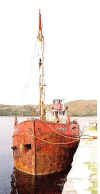
Nigel Robson of Edinburgh came across Pibroch on a visit to Western Ireland and kindly sent us these excellent photographs some years ago. Sadly she was scrapped in 2010 and the final photographs taken by Ruthan O'Conner, will be found on the web site.
We believe she was second Pibroch commissioned by the White Horse Distillery. (The first , built in 1932 had the funnel forward of the wheelhouse)
A wonderful photograph of 'Spartan' unloading on the beach on Iona. Courtesy Crawford Alexander Collection
VIC 18 "Spartan" Scottish Maritime Museum
See: www.scottishmaritimemuseum.org
Spartan is normally at the Irvine site (Harbourside, Irvine Tel: 01294 278283) May be away on tour at times.
(This vessel is also on the NRHV list, Ed.)
VIC 24 "Advance" Web: http://puffersandvics.org/VIC24.htmBuilt 1942 Richard Dunston of Thorne.
VIC 42 was built to 66.85 feet (20.39m) overall like many other VICs from this yard and remained in Naval service until 1943 when she was sold out. We understand this vessel still exists, and is shown on the NRHV list to be in now in Plymouth after many years in Holland .
See also: https://www.nationalhistoricships.org.uk/
VIC 27 Web: http://vic27.co.ukBuilt 1934, Pimbolt. Variously "Auld Reekie", now "Maggie"
Built by Pimbolts of Northwich in 1934 this vessel is under restoration at Crinan Boatyard (2017). The History of Vic 27 may be found on the web site and a copy of her log book may is hel at the National Archive, Kew and may be seen here: /http://vic27.co.uk/history/documents/Also turn to the Merchant Navy Nostalgia site where you will find a full history of this vessel together with a number of early photographs in an article by Jim Pottinger - http://iancoombe.tripod.com
VIC 32. Web: www.savethepuffer.co.uk
Built 1943 Dunston's Shipyard, Thorne 66'4 (20.4m) overall.
VIC 32 Photo: Peter Wilberforce
VIC 32 is thought to have worked as a supply vessel in Scapa Flow during the second world war - perhaps carrying aviation spirit. Now she is nicely restored and regularly available in steam for holidays. She is run by the Puffer Preservation Trust who have recently had her re-boilered. but of course maintenance is always on-going and needs public support. The Trust has an active web site that gives more details including specifications of the boat, and a series of black and white photographs from her working days which will be invaluable to model makers.
VIC 56
Web: www.vic56.co.ukBuilt 1945, 85'0 (26.15m) by J Pollock & Son & Co, Faversham.
She is currently moored at Chatham Historic Dockyard.
VIC 56 is in excellent working order as a coal fired steamboat and maintained by a small group of volunteers. There are public open days a few times ayear. . Notes about open days, and a full history may be found on the web site
VIC 72 "Eilean Eisdeal (Vital Spark)
Diesel powered, she was built in 1944 by S & D Brown, Brams Dry Dock, in Hull. In 1994 she traded for the Easdale Shipping Company who renamed her Eilean Eisdeal. Now at Inverary Maritime Museum she was renamed in 2006 Vital Spark of Glasgow.
There are useful photographs of VIC 72 on the Museum site, current and in her working days. Scheduled trips.
(This vessel is also on the NRHV list.)
VIC 96
Web: www.vic96.co.uk
Built 1945 by Pollock & Son & Co Ltd. Faversham.
She was originally commissioned by the War Office in 1945. Like other VICs, she carried supplies to the moored RN fleets in ports such as Sheerness and Chatham during WWII. She is still under steam, powered by her original Crabtree coal fired engine. This vessel was at the Maryport Steamship Museum, Maryport, Cumbria, but left there on 5th July 2009 to voyage home to Chatham where she now is to be found in No1 Basin where model makers will find her, (although she is currently out of the water (2012) at Acorn Wharf.) Contact the trust about visits.VIC 96 is now in the hands of a restoration group. - The VIC 96 Trust for more information.
Our photograph is a detail from the photo previously on the Maryport Steamship Museum website, with kind permission. Click on the photograph for a slightly larger view.
VIC 99
This photograph of VIC 99 was sent to us in Nov 2008 . It was was taken by Robert Anderson about eighteen years ago which would make it around 1990. It's interesting to compare the view with that of the VIC at the head of the page which has similar bulwarks and wheel house, and that of VIC 32.
Photo: Robert Anderson circa 1990
Dileas (The Gaelic word for Faithful)
This charming Puffer Dileas, built by Eddie Webb of Knitghtcote MBC, features working lights, cabin illumination a smoke generator, Western Islands charts on the miniature chart table, and a deck hand forward carrying an illuminated lantern!
Dileas steaming out with a load for Mull Here she is again, in port at Knightcote
Some suppliers of Puffer Kits
"Trilight" Clyde Puffer. 1/72 Deans Marine.
Web: www.deansmarine.co.uk
"Incholm" Clyde Puffer. Kingston Mouldings.
http://www.jotika-ltd.com/
Web: www.kingstonmouldings.co.uk
" North Light" Clyde Puffer. 1/32 Caldercraft/Jotika
Web:
"Anzac" Clyde puffer or generic. Waverley Models
Web: www.waverleymodels.co.uk
Plans, Drawings, Articles and Advice for Model Makers
"Steam Coasters & Short Sea Traders", great technical drawings etc.
"Sealight" Drawings 1/4 = 1'. Brown Son & Ferguson www.skipper.co.uk
Clyde Maritime
A beautifully researched site with a full index of the VICs and another of the original Puffers. Many photographs of puffers - many since scrapped - and lots of good material for detailing http://puffersandvics.org/puffer_index.htm
National Register for Historic Vessels (NRHV)
Web: www.nationalhistoricships.org.uk
Lists and illustrates a number of Clyde Puffers including VIC 24, Vic 32 and provides suitable links where these are known.
(This site has an excellent research facility and we recommend it for any vessel, Ed.)
TradBoat
© Charles Smith Publication